Sharpen your wits and your weapons—it’s time to explore the (tiny epic) dungeon!
What Is Tiny Epic Dungeons?
Tiny Epic Dungeons is a cooperative dungeon crawl game for 1 to 4 players, ages 14 and up, and takes about 30 to 60 minutes to play. It’s currently seeking funding on Kickstarter, with a pledge level of $25 for a copy of the game, $30 for the deluxe edition with extra Kickstarter content, or $40 for the deluxe plus the Stories expansion. Or, if you want to print it yourself, you can get the print-and-play files for $10 (though it doesn’t include the 3D models). The game is set in a typical swords-and-sorcery fantasy world with monsters and heroes, so you can play with younger kids; since the players are working together, you can also help less experienced players with strategy.
Tiny Epic Dungeons was designed by Scott Almes and published by Gamelyn Games, with illustrations by Ian Rosenthaler and Nikoletta Vaszi, graphics by Benjamin Shulman, and miniatures models by Chad Hoverter.
New to Kickstarter? Check out our crowdfunding primer.
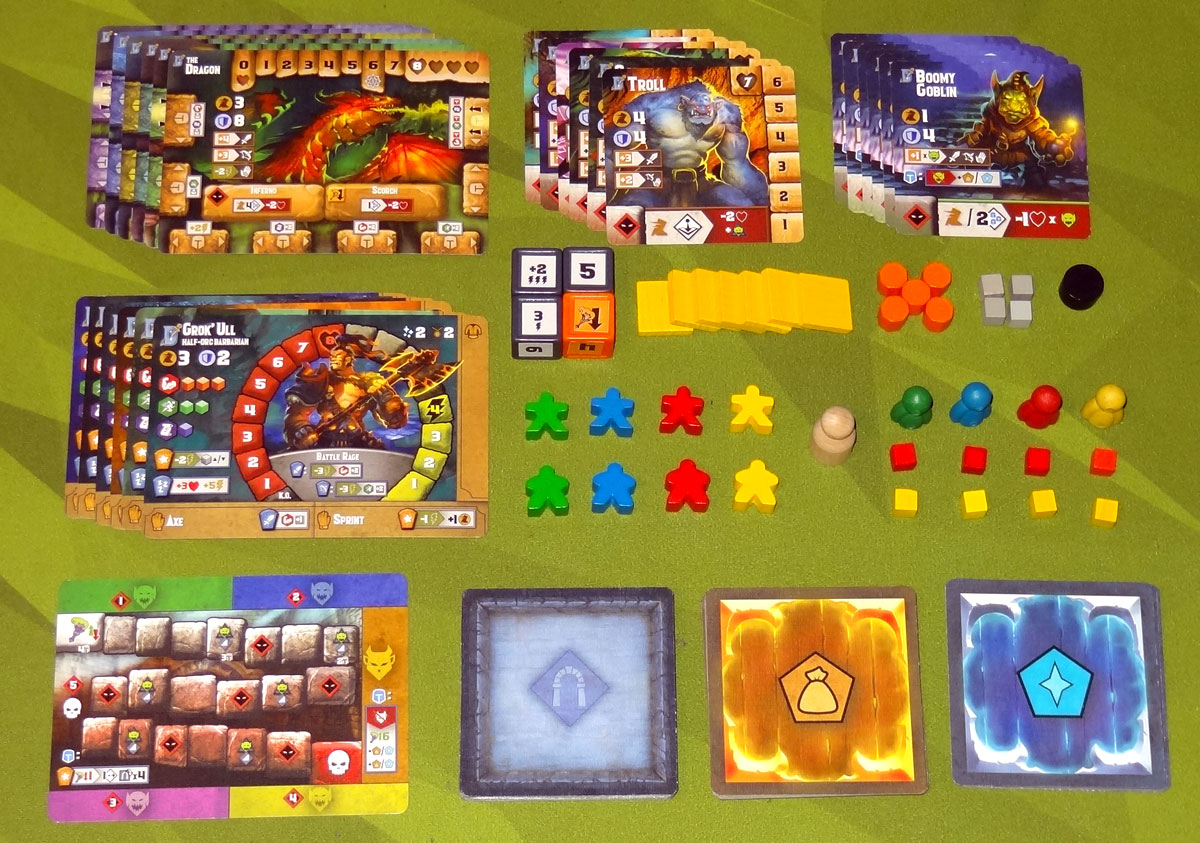
Tiny Epic Dungeons Components
Note: My review is based on a prototype copy, so it is subject to change and may not reflect final component quality. The prototype used generic pawns but the finished game will have custom miniatures for the heroes. Stretch goals may also add or upgrade components.
Here’s what comes in the base game:
- 6 Boss mats
- 6 Minion cards
- 6 Goblin cards
- 6 Hero mats
- 3 Hero dice
- 1 Enemy die
- 7 Trap Disarm tokens
- 5 Ritual tokens
- 4 Minion Health tokens
- 1 Torch token
- 4 Goblin pawn
- 4 Minion pawn
- 1 Boss pawn
- 6 Hero miniatures
- 4 Hero Health tokens
- 4 Hero Focus tokens
- 1 Torch mat
- 28 Dungeon cards
- 26 Loot cards
- 14 Magic cards
(In case you’re not already familiar with the Tiny Epic games, each one comes in a compact box, and they utilize cards rather than boards, along with smaller tokens, to fit some hefty gameplay in a small package. Each game is a different theme and gameplay style.)
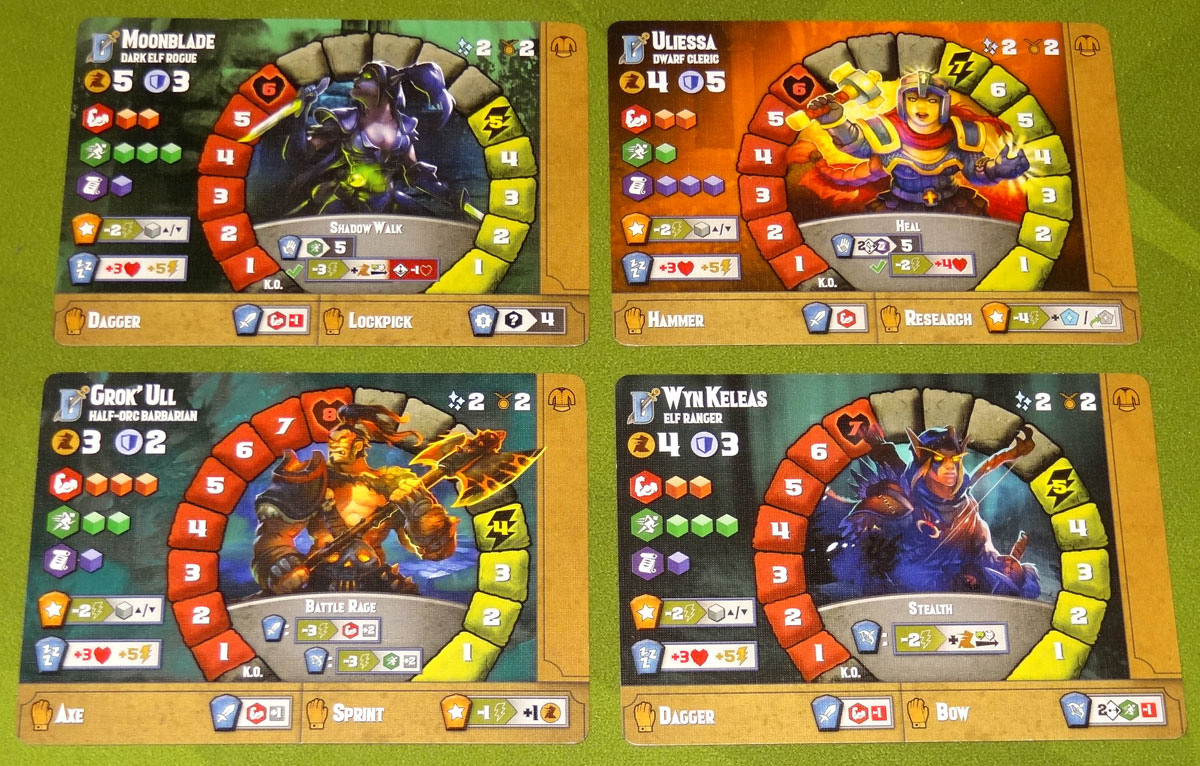
Tiny Epic Dungeons uses square cards for the dungeon rooms, as well as the loot and magic spell cards you’ll be collecting and the enemies. Oversized cards are used for the player mats, the boss cards, and the torch tracker that serves as a game timer. There’s a lot going on in this game, and all of the cards have various icons explaining what they do. It can take a bit of time to get used to what they all mean—I had to refer to the rulebook reference for a lot of them the first few times I played because they weren’t immediately intuitive to me.

The artwork on the cards is fun, though I will note that does have the somewhat stereotypical busty women and beefy men for several of the heroes. The dungeon rooms have a lot of fun details with thematic effects—for instance, a room with sleeping goblins lets you pick up some loot if you pass an agility check, but adds a goblin to the room if you fail.

This is the first Tiny Epic game that uses miniatures—previous games have used Gamelyn’s ITEMeeples, which can hold items, but for this dungeon crawl they decided to have custom figures for each hero. The goblins, minions, and bosses are all represented with more generic pawns or meeples (because there are so many different types but only so many of them in play at any given time). I’m always impressed by how much is packed into these small boxes, and I imagine miniatures will make for a tight fit, but they’re definitely a fun addition.
The Deluxe edition adds the Potions & Perils mini-expansion, which includes potion cards, as well as more bosses, minions, goblins, and a dungeon room. The Stories expansion adds 6 more heroes (with minis) and more of each type of card, plus introduces story cards that give you side quests and dungeons with multiple levels. My prototype did not include most of this additional content, so what you see in this review will be primarily from the base game.
How to Play Tiny Epic Dungeons
You can download a copy of the rulebook on the Kickstarter campaign page.
The Goal
The goal of the game is to locate the boss’s lair and slay the boss. As with many cooperative games, there are several ways you can lose:
- A hero starts their turn unconscious in a room with a monster and there are no conscious heroes with them.
- You need to place a goblin but there are already four goblins in the dungeon.
- The torch reaches the end of the track.
- There are no more open passageways to add dungeon cards but the lair has not been placed.
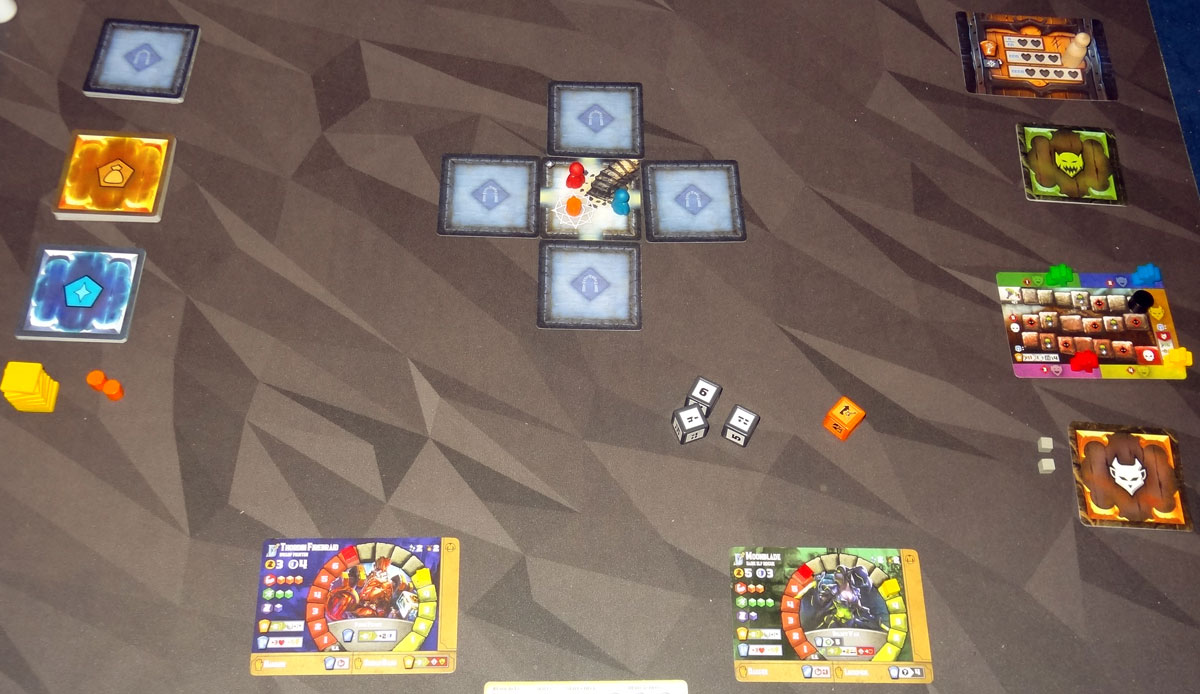
Setup
The dungeon deck will have a mix of rooms, minion cards (1 per player), and the lair card based on the number of players. The entrance card is placed in the center of the table with one ritual token on it, leaving room to form a 7×7 grid of rooms around it. The top four room cards are placed face-down adjacent to the entrance. Shuffle each of the decks separately: goblins, minions, loot, and magic. Shuffle the boss cards and place one face-down to the side without looking at it, and return the rest to the box. Place the ritual tokens, dice, and trap disarm tokens nearby, as well as the boss, minion, and goblin tokens.
Set the torch card to the side, with the token placed on the starting space according to the player count. Leave room above and below the torch card for goblin cards. Each player gets a hero card, placing a health token and focus token at maximum on the tracks. Place your hero miniature on the entrance card.

Gameplay
On your turn, you get to move and do one action (in either order), and you may also take as many free actions as you wish. Movement is based on your character’s speed, but your movement is interrupted if you run into an enemy or a trap that you don’t escape. Most of the dungeon rooms have actions that you can take while in them—but only if you’re not alone with an enemy in that room, of course! No digging around for loot if there’s a goblin watching you. Your character sheet also has actions you can do: everyone has two starting actions for their two hands, as well as some other actions or bonuses in the center below their portrait—usually a melee attack and some other abilities. As you gain loot, hand items will cover up these actions and provide other abilities instead. Everyone also has a “rest” action that recovers 3 health and 5 focus.
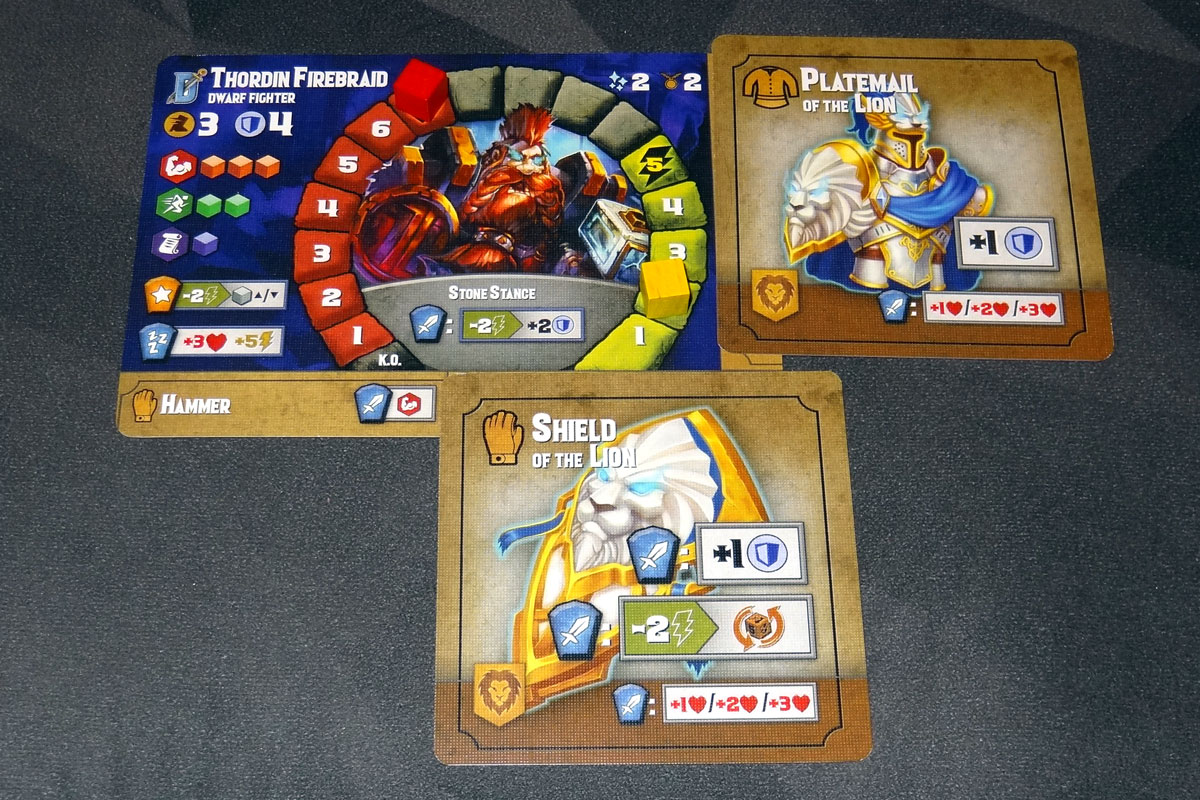
Regular actions are blue and free actions are orange. One free action that each player can do is spend 2 focus to increase or decrease a die. Spellcasters start with a “Research” action that lets them spend focus to draw a magic spell card. While most dungeon rooms have regular actions, there are some that include free actions instead.
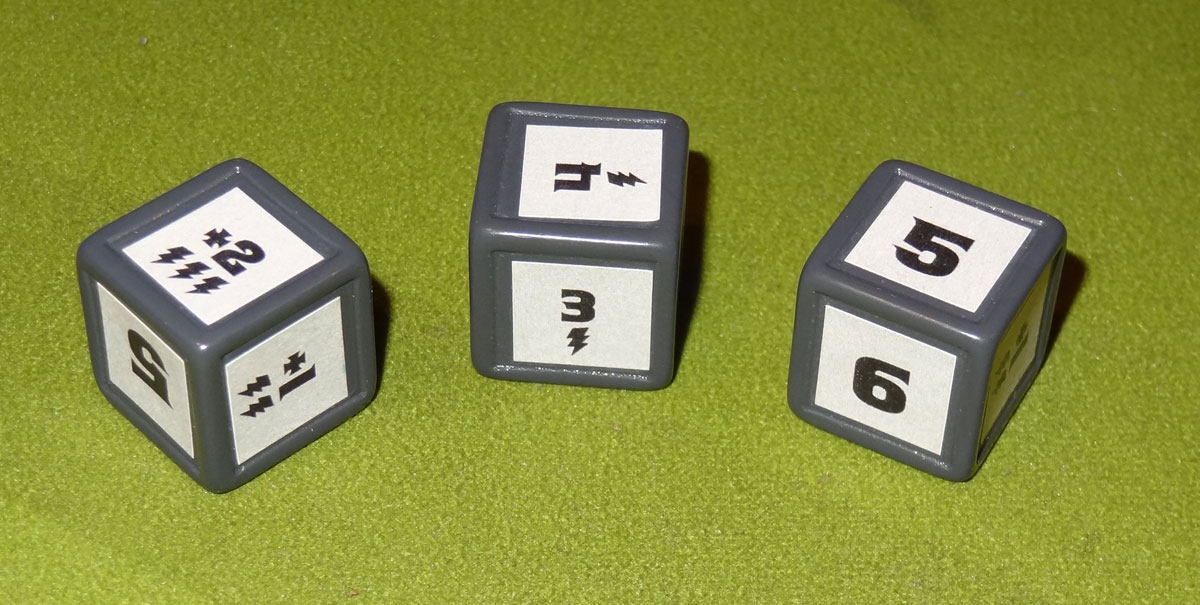
There are various actions that require a skill check, based on one of your three skills: strength, agility, and intellect. Your character sheet shows 1 to 3 cubes next to each skill. When you perform a check, you roll that many dice, but then choose one die to use—though the “1” and “2” may be added to other dice. Also, if you succeed at a check, you gain focus based on the focus icons on any leftover dice that you did not add to your check.

At the end of your turn, you decrease the torch track by one, which may trigger one of two effects: spawn a goblin on the entrance card, or activate all enemies on the board.
There can be up to 4 goblins on the board: you place the corresponding pawn on the board, and then draw a goblin card and place it next to the torch track to see which goblin it is. Every time the torch tracker reaches the black diamond icon, all of the goblins activate in order, and then all of the minions activate in order, moving around or attacking. Many of the goblins do damage based on the number of goblins on the board, so while they start off weak they can wreak a lot of havoc if you don’t keep a lid on them. Minions, meanwhile, are more dangerous and can do a lot of damage right off the bat. Defeating goblins will get you rewards (usually loot, and sometimes a choice of something else like health or focus, spells, or even free explore actions to reveal a dungeon card). Defeating a minion will give you two cards (loot/magic) and also raises the torch tracker 6 spaces, buying you more time.
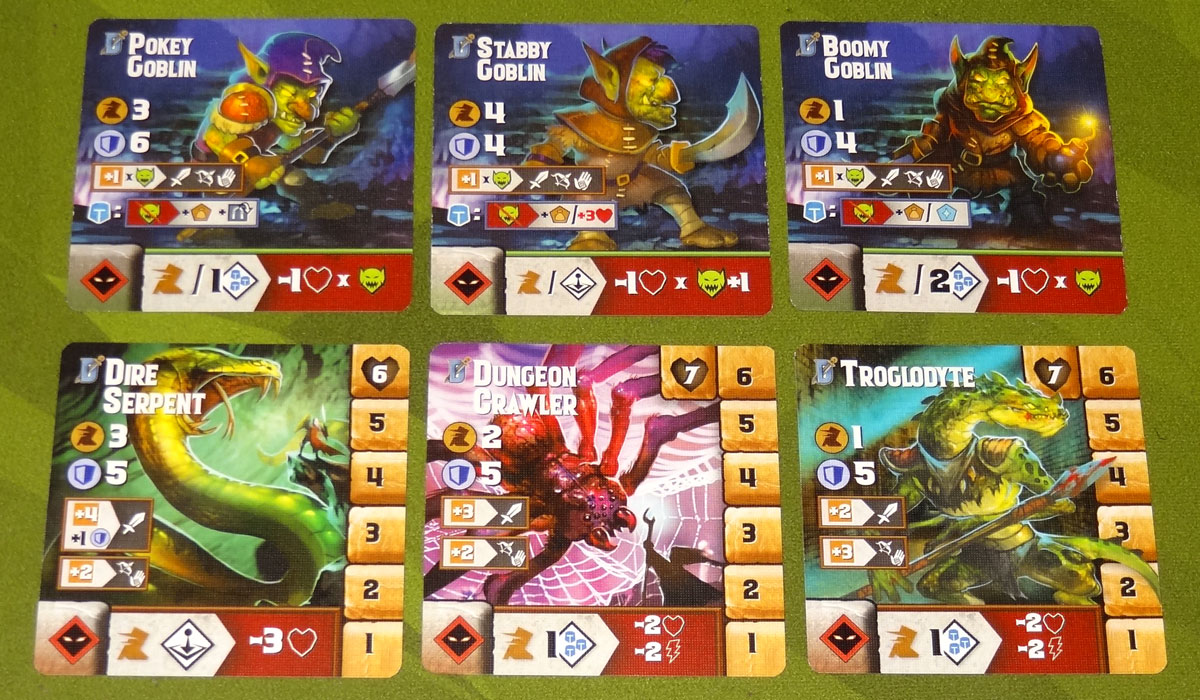
Attacking goblins and minions isn’t without risk: if you don’t defeat the enemy, it gets a counterattack based on the enemy die. Enemies may have different counterattacks based on whether you attacked with melee, ranged, or spell. The enemy die also has a face that lowers the torch by one instead of hitting you.
In order to enter the boss’s lair, you must first find and defeat all of the minions—each time you do, you place the minion’s health cube onto the boss card. Once you have one boss card per player, the lair can be unlocked as a free action (when you’ve found the lair card in the dungeon). The boss card is flipped over to reveal the boss, and the boss pawn is placed on the card. The minion health cubes are placed at the maximum health—you’ll have to bring all of them to zero to defeat the boss. Also, the torch card is flipped over to the boss side, and the torch tracker is placed on the space matching the player count.

The boss card itself represents the interior of the lair, and has several spaces along the edge of the card—you can move into and around the lair (one movement point per space), which gives you various effects depending on where you stop moving. Generally, the spaces near the entrance aren’t so great—you might lose focus or subtract from your skill checks—but going deeper into the lair can increase your skill checks so you can do more damage.
However, before you go bashing the boss, there’s something important: the boss’s health tokens cannot be reduced to a space with a ritual icon until you’ve performed a ritual! The entrance room and the minion rooms all have ritual tokens on them. You’ll have to taunt the boss—a free action costing 2 focus that makes the boss move toward you—out of its lair and through the rooms with ritual tokens. Each time you do, you cover up a ritual icon, and the boss is now vulnerable. (Some bosses have multiple ritual icons.)
The boss has its own effects when it’s activated, and also has a special effect when the “lower torch” icon is rolled for its counterattack (in addition to lowering the torch).
Game End
If you reduce all of the boss’s health tokens to zero, you defeat the boss and win! As noted earlier, there are multiple ways to lose.
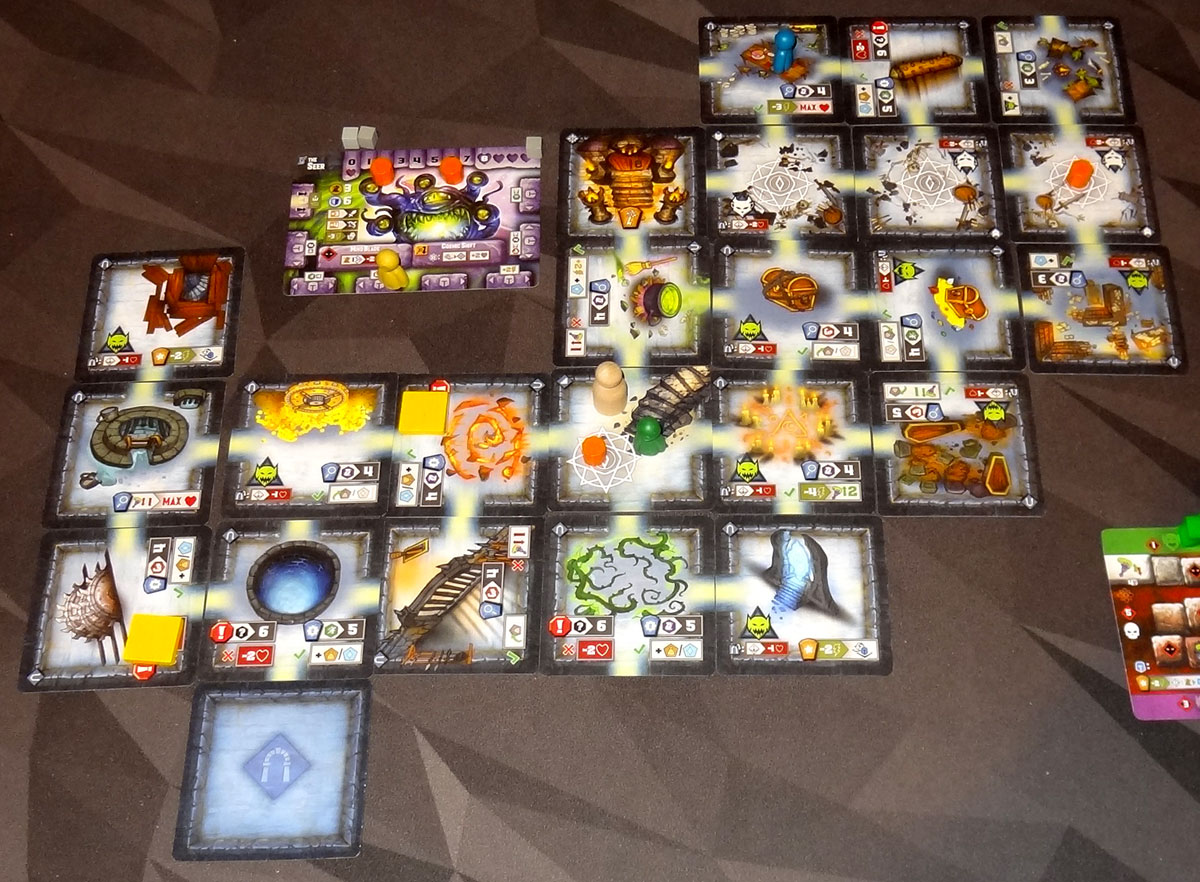
Why You Should Play Tiny Epic Dungeons
As you’re probably aware, I’m a big fan of the Tiny Epic games—I’m a vocal critic of game boxes that are way too big for their contents, so the concept of packing as much as possible into a tiny box appeals to me, especially since the games themselves are still pretty hefty when it comes to gameplay. I recognize that not everyone is a fan of the tiny tokens or replacing boards with cards, but this one doesn’t have quite as many small things to keep track of as some of the other titles, and the replacement of mini-meeples with 28mm miniatures may give it a table presence that feels closer to one of your bigger-box games.
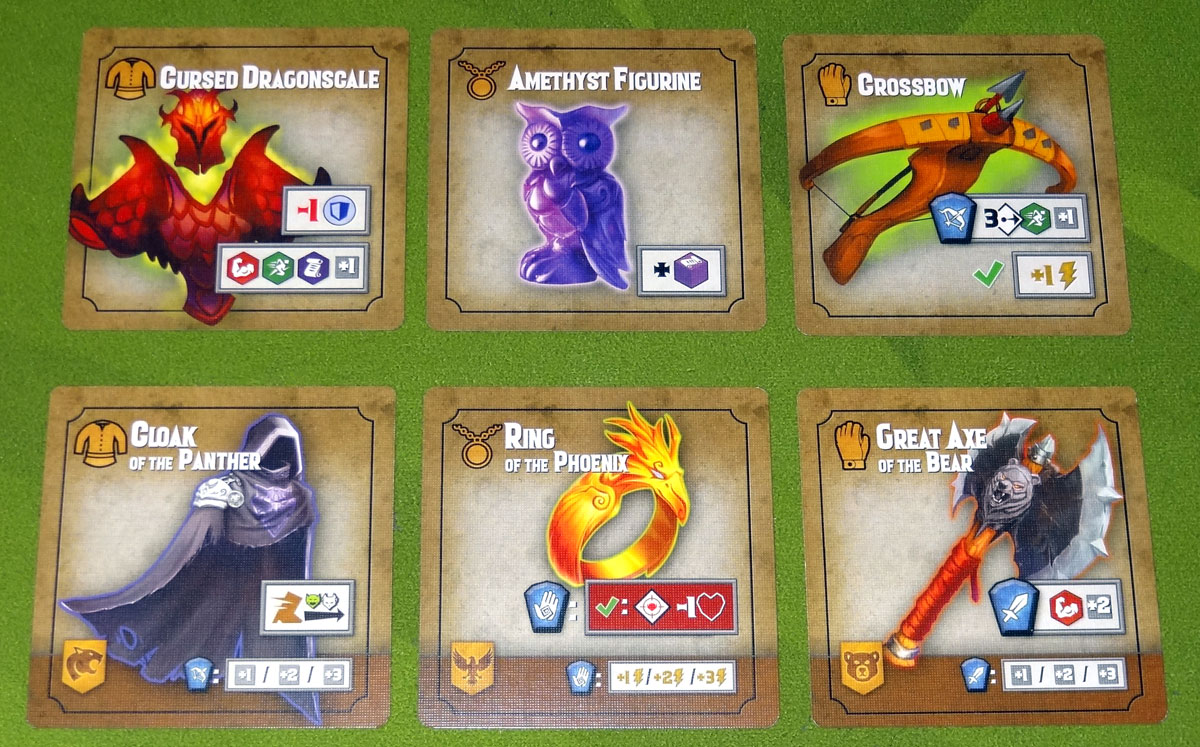
Tiny Epic Dungeons is a dungeon crawl, and some of it sticks to some tried-and-true territory: the heroes and enemies (at least in the base set) all seem familiar, and you wander through square rooms as you fight goblins, dodge traps, and dig for loot. (I’ve always wondered a little about that: shouldn’t you try to gear up a bit more before you charge into a dungeon, rather than hoping you’ll get better equipment once you’re in there? But I digress.) The skill checks are a little different from what I’m used to: there are only 3 skills to worry about, and the fact that you only choose one die to use rather than just adding up all of them is a bit of a tweak. That makes the 1s and 2s more valuable, because you can add those to a roll, which means in many instances you’re hoping for a mix of high and low numbers. 3s and 4s are just terrible, though.
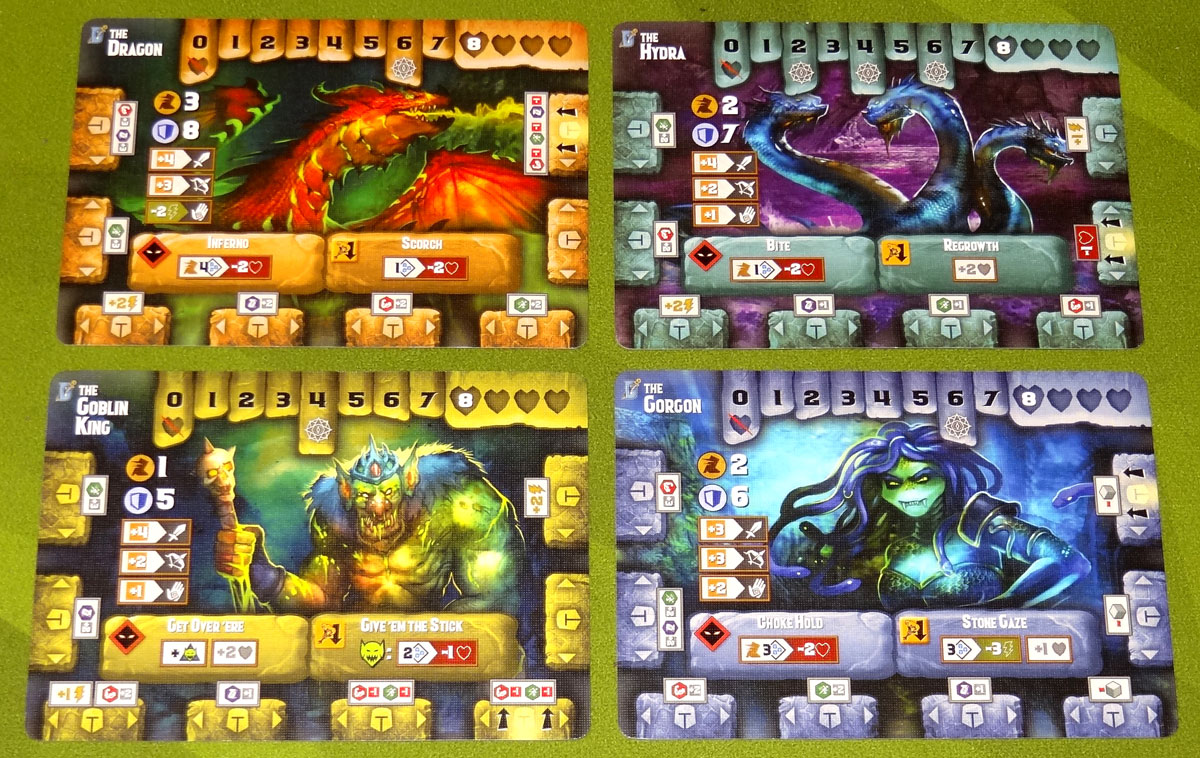
Another interesting factor was the way the boss fights work. The lair is a room of its own, and if you can get far enough into it, the boss takes more damage from your attacks. But first you have to drag it out of the lair for the rituals, as every boss has at least one ritual space on its health track. This run-and-taunt phase of the game is new to me, and I haven’t learned how best to handle it—once you’ve gotten the boss through the requisite ritual spaces, is it better to taunt it back to the lair where you can do more damage, or attack it out in the open so you spend less time running around? It also depends a lot on how many ritual spaces the boss has, and how your dungeon was laid out: if you’re lucky, there’s a ritual space right near the lair and you don’t have to run too far. Some of those heroes are slow.

There’s a good mix of heroes: some heroes hit hard with melee, some are agile and good with ranged attacks or disarming traps, and a few focus on casting spells. The one thing that I found odd was that although there are different mixes of the skill levels (everyone in the base game has a 1, a 2, and a 3), intellect only comes in 1 or 3—there aren’t any heroes who are just moderately intelligent. Either you’re great at spells, or you don’t even bother picking any up. I know there are a few in the expansion with a 2 intellect, which may let you consider spells even while you specialize in a different type of attack.

Since you can only move and do one action on your turn (not counting free actions), there are some tough choices to make. You only have so much time to find and defeat the minions before your torch runs out, so there’s pressure to keep exploring. However, revealing a goblin or a minion deals damage to you, so stepping into a room is always a risk, and so you probably want to save your one action for fighting just in case. However, you also need to spend actions fighting existing goblins or disarming traps, or else it becomes impossible to get around the dungeon (and those goblins start hitting a lot harder). It’s tough to maintain that balance between opening up new rooms and managing what’s already out there. I’ve had games where we ran out of time before finding the next minion, and games where we revealed too many minions at once and they wiped us out.
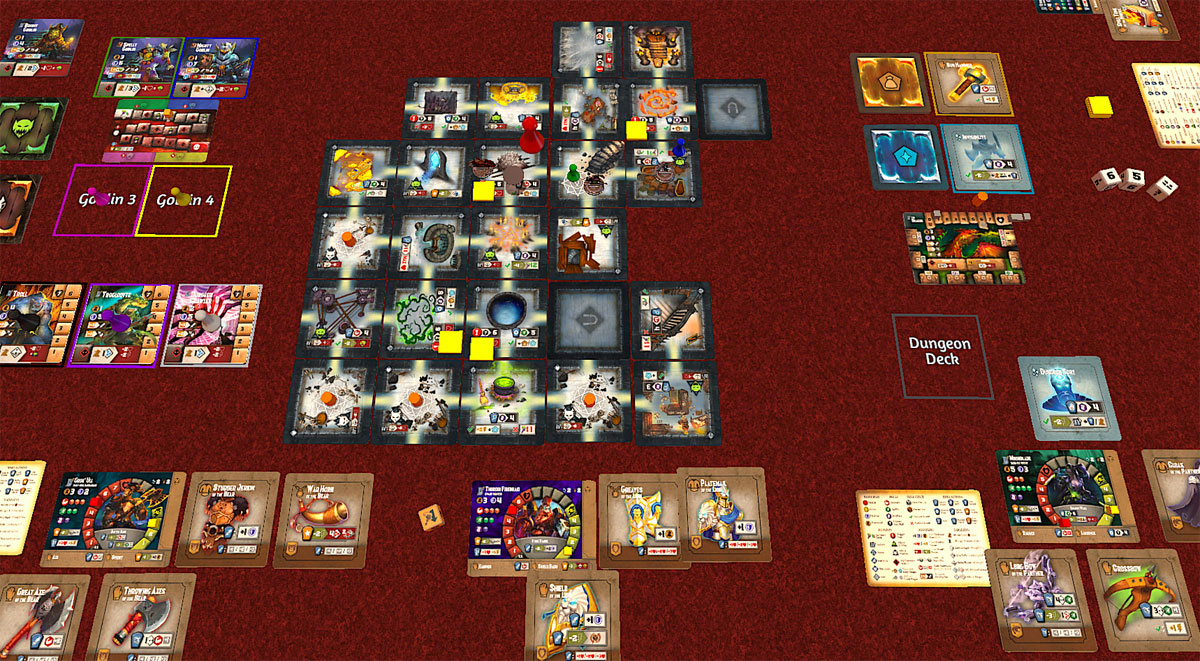
I enjoyed playing with my daughters enough that I built a Tabletop Simulator module myself (with permission and graphics from the publisher) so I could play it with some friends online as well. (Currently that module isn’t publicly available, though I’ve since shared it with Gamelyn Games so they can decide whether to make it public or build on it themselves for future use.)
I won’t lie: I have a lousy track record so far. Of the 10 times I’ve played as of this writing, I haven’t won a single time yet! Though, in my defense, 7 of those games included at least one person learning the game for the first time, so I’m taking that into account. And even with the losses, it’s been a lot of fun. There have been some truly epic moments, like casting the “Dark Bargain” spell that heals several players but also spawns a goblin… which then tipped the balance and knocked us out. My closest game was getting the boss down to about 3 health before we were defeated, but there have been games where we ran out of time before even finding all the minions. I’ve played with two of my daughters (ages 14 and 7) and I’ve also played with adult friends. I’ve enjoyed the challenge: discussing as a group which way we should go, watching the torch track so we know when goblins and minions are going to attack so we can get everyone into position, helping each other get loot that fits each character. One of these days, I’m going to beat this game!
If you like dungeon crawls and you’re up for a challenge, consider exploring Tiny Epic Dungeons. It’s bigger than it looks from the outside!
For more information or to make a pledge, visit the Tiny Epic Dungeons Kickstarter page!
Click here to see all our tabletop game reviews.
![]() To subscribe to GeekDad’s tabletop gaming coverage, please copy this link and add it to your RSS reader.
To subscribe to GeekDad’s tabletop gaming coverage, please copy this link and add it to your RSS reader.
Disclosure: GeekDad received a prototype of this game for review purposes. While I was compensated afterward by Gamelyn Games for my time building the Tabletop Simulator module, that was independent of the arrangements for this review and was offered after I had already created the module.
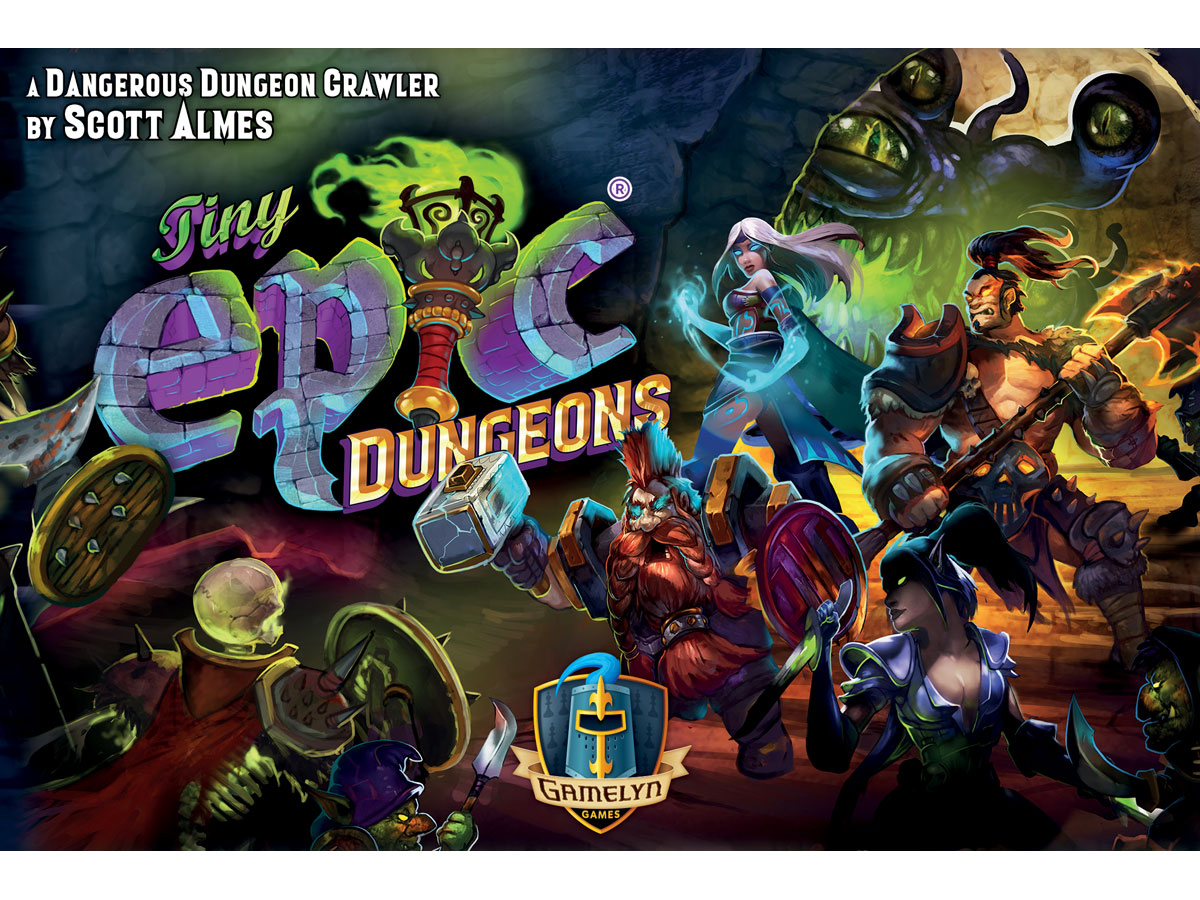


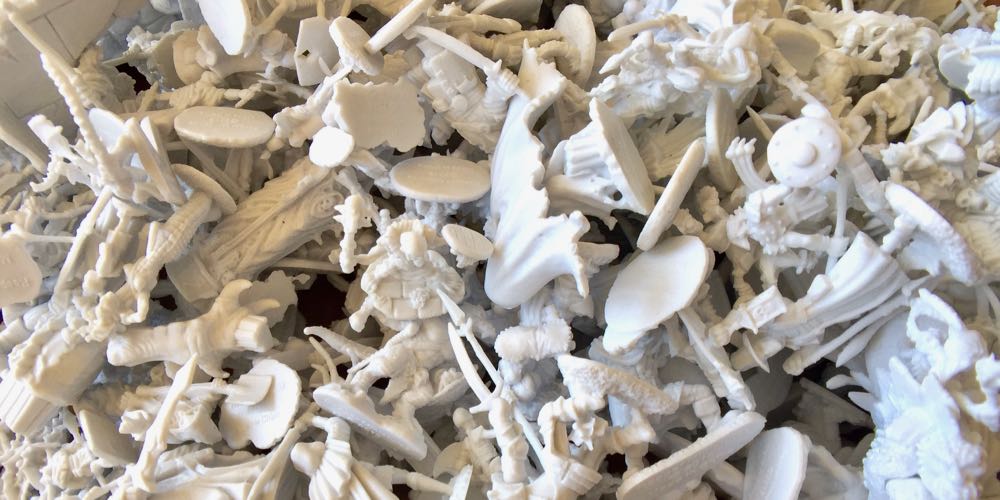


Could you at least comment on the pervasive sexist and objectifying art work?
While you may be okay with these images being shown to your daughters as part of the deluge of casually sexist media, other families might not.
All of the female characters, including the expansion characters, being underarmored (especially in contrast to the male characters) for the purpose of sexualization, showing cleavage and/or wearing skintight outfits, and even in sexualized poses on the cover (and that’s the “fixed” artwork, after they realized how bad the original box cover was).
In particular this should be pointed out, because it is a stark change for Gamelyn, and potential customers/backers might be used to their much more family friendly art.
Hi, I did mention this in the components section that it had stereotyped figures in the illustrations, though I didn’t go into as much detail as perhaps I should. The prototype had a limited number of the characters, so I admit I didn’t pay much attention to what specifically was included in the expansion and hadn’t seen any of the stretch goal characters until they were revealed after my review was published. I saw the ongoing conversation and the small adjustments Gamelyn has made to the artwork so far, but I had responded to that more on Twitter rather than in my article here since much of the conversation and Gamelyn’s response happened after this was already published.
As far as it being a stark change for Gamelyn, this isn’t the first time or the only time they’ve had sexualized characters—I pointed this out in Tiny Epic Zombies as well, particularly when the player characters flipped to the zombie side and had torn clothes. In the prototype I I think it was just the scientist, but some of the other added characters had similar issues, and I wouldn’t call all of the artwork in their games “family-friendly.” I think they tend to pull from whatever genre they’re working in and have used a lot of different styles over the course of their games. It happens that some of their more recent games have used a more cartoony style, but that’s not true of the whole Tiny Epic line.
That said, I agree with you that it’s frustrating to see that all but one of the women in the game have the same thin-waisted, busty body type, and most of them have similar revealing clothing; the men have a much bigger variety in body types. Gamelyn draws from the tropes of whatever genre it’s working in, but it would be great to see them be able to shift the conversation by having better representation.
As far as what each family is okay with or not: I have conversations with my kids about how characters are portrayed, what characters are available to play in a game, and so on. When I agree to review a game, I’m often doing that without having seen much of the material ahead of time, but I hope that my review helps you make a decision whether or not to back or purchase a game. I would never suggest backing or purchasing a game without looking at whether or not you like the artwork, any more than I’d suggest making a purchase without knowing how the game plays. If the images I included in my review let you know that this game is not for you, then that was the intended result as well.
Given the conversation surrounding this particular title, I may try to put more than a line in future reviews when it comes to artwork. I have tried to highlight when a game has representation that I feel is particularly well-done, and call out things that I think were missed, but I still have my own blind spots as well and I appreciate you bringing it up.
Thank you for addressing this, it would be incredibly satisfying to have Gamelyn directly address this half as much as you did here.
It’s certainly an ongoing conversation, and one that I hope Gamelyn Games will figure out how to participate in more fully. I like that they’ve been able to push against the trend of huge, mostly empty boxes, so this is perhaps an area they haven’t really considered as seriously until this title brought a lot of attention to them specifically. One thing I have appreciated about Gamelyn is that they do have women as playable characters in their games, because in many other games my daughters argue over who gets to be the one female character in a game. That said, I recognize that just increasing the number of women in a game does not always mean better representation—how they’re depicted and presented is also important.